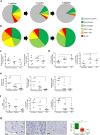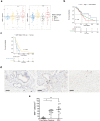Immunoevolution of mouse pancreatic organoid isografts from preinvasive to metastatic disease
- PMID: 31439856
- PMCID: PMC6706454
- DOI: 10.1038/s41598-019-48663-7
Immunoevolution of mouse pancreatic organoid isografts from preinvasive to metastatic disease
Abstract
Pancreatic ductal adenocarcinoma (PDA) has a highly immunosuppressive microenvironment, which is contributed by the complex interaction between cancer cells and a heterogeneous population of stromal cells. Therefore, facile and trackable models are needed for integrative and dynamic interrogation of cancer-stroma interaction. Here, we tracked the immunoevolution of PDA in a genetically-defined transplantable model of mouse pancreatic tumour organoids that recapitulates the progression of the disease from early preinvasive lesions to metastatic carcinomas. We demonstrated that organoid-derived isografts (ODI) can be used as a biological source of biomarkers (NT5E, TGFB1, FN1, and ITGA5) of aggressive molecular subtypes of human PDA. In ODI, infiltration from leukocytes is an early event during progression of the disease as observed for autochthonous models. Neoplastic progression was associated to accumulation of Maf+ macrophages, which inversely correlated with CD8+ T cells infiltration. Consistently, levels of MAF were enriched in human PDA subtypes characterized by abundance of macrophage-related transcripts and indicated poor patients' survival. Density of MAF+ macrophages was higher in human PDA tissues compared to preinvasive lesions. Our results suggest that ODIs represent a suitable system for genotypic-immunophenotypic studies and support the hypothesis of MAF+ macrophages as a prominent immunosuppressive population in PDA.
Conflict of interest statement
The authors declare no competing interests.
Figures





References
Publication types
MeSH terms
Substances
LinkOut - more resources
Full Text Sources
Medical
Molecular Biology Databases
Research Materials
Miscellaneous

